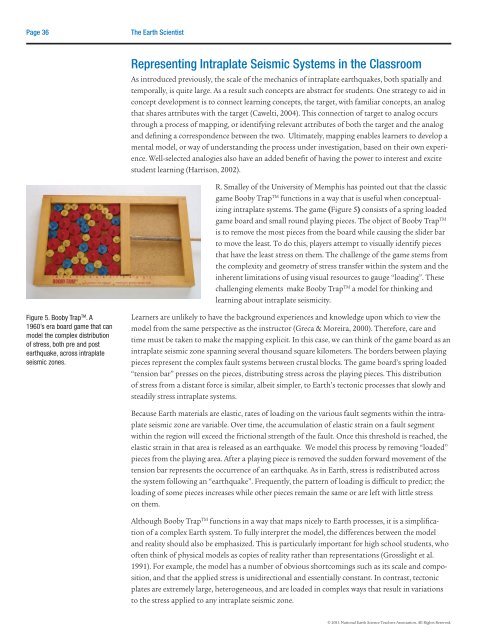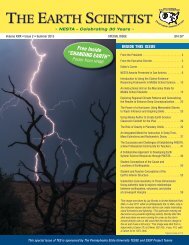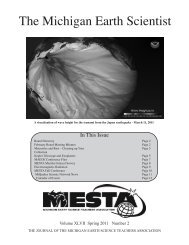The Earth Scientist
The earTh ScienTiST - NESTA
The earTh ScienTiST - NESTA
You also want an ePaper? Increase the reach of your titles
YUMPU automatically turns print PDFs into web optimized ePapers that Google loves.
Page 36<br />
<strong>The</strong> <strong>Earth</strong> <strong>Scientist</strong><br />
Representing Intraplate Seismic Systems in the Classroom<br />
As introduced previously, the scale of the mechanics of intraplate earthquakes, both spatially and<br />
temporally, is quite large. As a result such concepts are abstract for students. One strategy to aid in<br />
concept development is to connect learning concepts, the target, with familiar concepts, an analog<br />
that shares attributes with the target (Cawelti, 2004). This connection of target to analog occurs<br />
through a process of mapping, or identifying relevant attributes of both the target and the analog<br />
and defining a correspondence between the two. Ultimately, mapping enables learners to develop a<br />
mental model, or way of understanding the process under investigation, based on their own experience.<br />
Well-selected analogies also have an added benefit of having the power to interest and excite<br />
student learning (Harrison, 2002).<br />
R. Smalley of the University of Memphis has pointed out that the classic<br />
game Booby Trap TM functions in a way that is useful when conceptualizing<br />
intraplate systems. <strong>The</strong> game (Figure 5) consists of a spring loaded<br />
game board and small round playing pieces. <strong>The</strong> object of Booby Trap TM<br />
is to remove the most pieces from the board while causing the slider bar<br />
to move the least. To do this, players attempt to visually identify pieces<br />
that have the least stress on them. <strong>The</strong> challenge of the game stems from<br />
the complexity and geometry of stress transfer within the system and the<br />
inherent limitations of using visual resources to gauge “loading”. <strong>The</strong>se<br />
challenging elements make Booby Trap TM a model for thinking and<br />
learning about intraplate seismicity.<br />
Figure 5. Booby Trap TM . A<br />
1960’s era board game that can<br />
model the complex distribution<br />
of stress, both pre and post<br />
earthquake, across intraplate<br />
seismic zones.<br />
Learners are unlikely to have the background experiences and knowledge upon which to view the<br />
model from the same perspective as the instructor (Greca & Moreira, 2000). <strong>The</strong>refore, care and<br />
time must be taken to make the mapping explicit. In this case, we can think of the game board as an<br />
intraplate seismic zone spanning several thousand square kilometers. <strong>The</strong> borders between playing<br />
pieces represent the complex fault systems between crustal blocks. <strong>The</strong> game board’s spring loaded<br />
“tension bar” presses on the pieces, distributing stress across the playing pieces. This distribution<br />
of stress from a distant force is similar, albeit simpler, to <strong>Earth</strong>’s tectonic processes that slowly and<br />
steadily stress intraplate systems.<br />
Because <strong>Earth</strong> materials are elastic, rates of loading on the various fault segments within the intraplate<br />
seismic zone are variable. Over time, the accumulation of elastic strain on a fault segment<br />
within the region will exceed the frictional strength of the fault. Once this threshold is reached, the<br />
elastic strain in that area is released as an earthquake. We model this process by removing “loaded”<br />
pieces from the playing area. After a playing piece is removed the sudden forward movement of the<br />
tension bar represents the occurrence of an earthquake. As in <strong>Earth</strong>, stress is redistributed across<br />
the system following an “earthquake”. Frequently, the pattern of loading is difficult to predict; the<br />
loading of some pieces increases while other pieces remain the same or are left with little stress<br />
on them.<br />
Although Booby Trap TM functions in a way that maps nicely to <strong>Earth</strong> processes, it is a simplification<br />
of a complex <strong>Earth</strong> system. To fully interpret the model, the differences between the model<br />
and reality should also be emphasized. This is particularly important for high school students, who<br />
often think of physical models as copies of reality rather than representations (Grosslight et al.<br />
1991). For example, the model has a number of obvious shortcomings such as its scale and composition,<br />
and that the applied stress is unidirectional and essentially constant. In contrast, tectonic<br />
plates are extremely large, heterogeneous, and are loaded in complex ways that result in variations<br />
to the stress applied to any intraplate seismic zone.<br />
© 2011 National <strong>Earth</strong> Science Teachers Association. All Rights Reserved.






